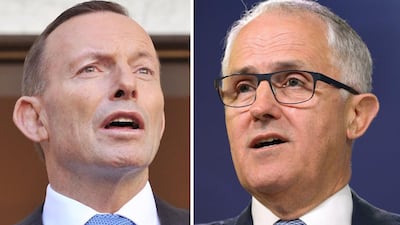Sydney // Tony Abbott was dramatically ousted as Australia’s prime minister yesterday in a snap party vote forced by rival Malcolm Turnbull, in what will be the country’s fourth leadership change in five years.
Mr Abbott, who came to power after a decisive general election victory in 2013, was forced into a leadership ballot with his Liberal Party colleagues after Mr Turnbull said the coalition government would be defeated without change at the top.
After his 54-44 victory, the former communications minister pledged to bring “economic vision” to the country but ruled out a snap national election.
“This has been a very important, sobering experience today. I’m very humbled by it,” Mr Turnbull said.
“We need to have in this country and we will have now, an economic vision, a leadership that explains the great challenges and opportunities that we face.”
Mr Abbott, whose views on issues such as gay marriage and climate change divided the community, made no comment after the vote.
Mr Turnbull, who is likely to be sworn in today, said his Liberal Party-led government would be “committed to freedom, the individual and the market”. He said he was not planning a snap poll to cement his leadership.
Mr Turnbull is seen as more socially progressive than Mr Abbott, who has resisted moves towards legalising gay marriage. He said he intended to maintain the government’s stance on issues such as climate change.
He said that under Mr Abbott, the government had been unable to explain its policies adequately to voters and he wanted to signal a new way forward.
“The Australia of the future has to be a nation that is agile, that is innovative, that is creative,” he said in Canberra, with foreign minister Julie Bishop by his side.
Ms Bishop, who had reportedly sided with Mr Turnbull to call on Mr Abbott to quit earlier in the day, retained her position as deputy leader of the Liberal Party by 70 votes to 30.
In the current parliament, whoever leads the Liberal Party becomes prime minister as head of the conservative coalition in which it is the senior partner.
It is not the first time in recent years that a prime minister has been removed by a party-room coup.
Mr Turnbull previously led the Liberal Party in opposition before being ousted by Mr Abbott in late 2009.
Moves against the unpopular Mr Abbott had been in the works for months.
He survived a leadership challenge in February after poor polling, policy backflips and an unpopular budget generated a backbench revolt, fuelled by questions about the prime minister’s judgement.
But in the months since, Mr Abbott has failed to turn around the polls, bolster the economy or stop damaging leaks from within his party.
Mr Turnbull, a former barrister and entrepreneur who represents an upmarket Sydney electorate, said yesterday that the government’s message was not getting through and that a new, more open, approach was needed. The popular minister, long considered one of the most credible alternatives to Mr Abbott, quit the cabinet in a shock move that triggered the party ballot.
Mr Turnbull said failure to change would mean losing power to Labor leader Bill Shorten at the next election, which is expected to be called some time next year.
He said Australia needed a style of leadership “that respects the people’s intelligence, that explains these complex issues and then sets out the course of action we believe we should take”.
The Labor Party has had a solid opinion poll lead over the government since last year, with a Newspoll survey last week finding that 63 per cent of voters were dissatisfied with Mr Abbott’s performance.
* Agence France-Presse

